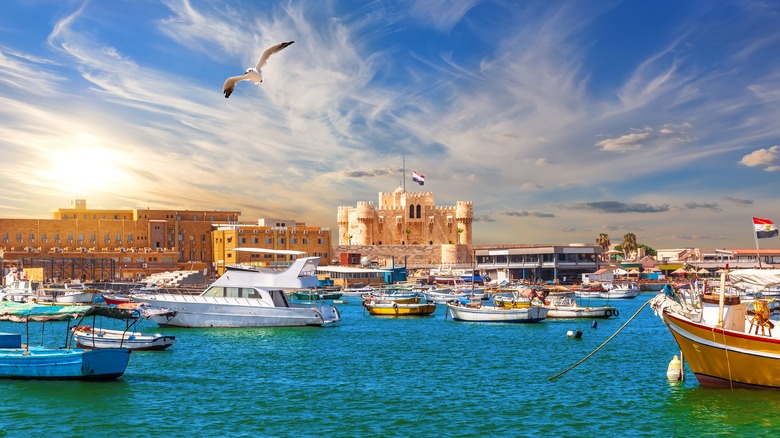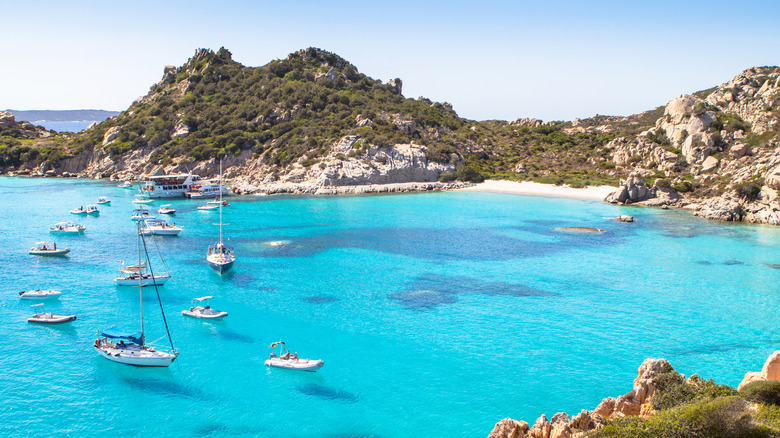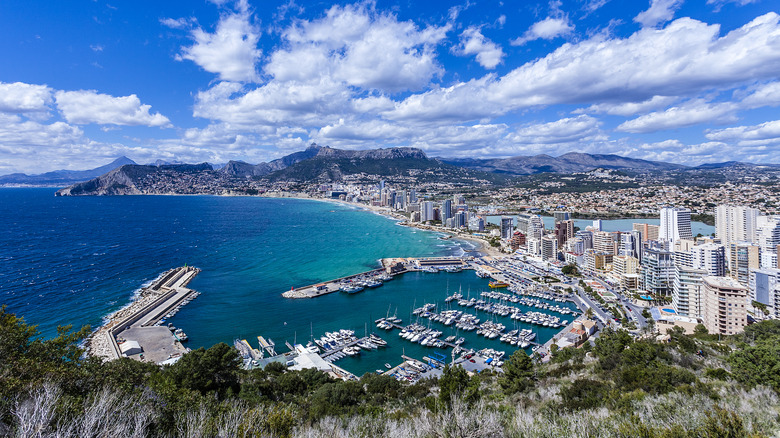Thoughts of a visit to the Mediterranean bring up images of cerulean waters, sunshine, pleasant temperatures (no matter the season), delectable dinners and drinks, and more history than you can shake a high school textbook at. However, there’s much more to the Mediterranean — which sits in between Europe, Africa, and Asia – than well-known destinations like the Amalfi Coast, Santorini, and Barcelona (although those are pretty great, too). This region is chock-full of vastly different cultures and cities, some of which will lead you to fewer headaches, crowds, and tourist traps than their cliché counterparts.
We combed through countless websites, travel guides, personal travel blogs, online reviews, and social media comments to determine which were the most underrated Mediterranean destinations to help you avoid the tourist traps and find the spots that are diamonds in the rough. After conducting our research, we chose these places based on how much authentic culture they’ve maintained throughout their many centuries, how easy it is to enjoy them without hordes of crowds, how beautiful their views are, and how storied their histories are. In these Mediterranean places, you’ll get the best of all worlds — even if you’re not entirely sure how to pronounce their names just yet.
Ephesus, Turkey

Rome may get all the credit when it comes to ruins, but Ephesus is right behind it as the second-largest Roman city — with well-preserved ruins to match. One of those ruins is the Temple of Artemis, which dates back to the sixth century and is one of the classic Seven Wonders Of The World. Ephesus is also a UNESCO World Heritage site due to its colossal amount of ruins, making it an archaeologist’s paradise.
Besides being a haven for history fans (it is one of the oldest cities in the world), Ephesus is also the place to go in the Mediterranean for religious buffs. It’s named throughout the New Testament, starting in Paul’s First Letter to the Corinthians. It was also said to have been visited by Biblical figures like Paul, John, and the Virgin Mary, who is thought to have died in the city. Today, her stone home and shrine still stand. Ephesus visitors can also see how people lived in the city, too. Its main street dates back to the first century, and it has archaeological items to prove it, including a brothel sign and busts of notable figures. The homes of the city’s elite are also exceptionally well-preserved on Bulbul Mountain, where tourists can check out nearly intact stone floors, wall art, and more.
Cádiz, Spain

Travelers to Spain often flock to big cities like Madrid for its remarkable history and Barcelona for its beautiful beaches and party scene. Unfortunately, most of them miss out on charming, quaint locales like Cádiz, a coastal city full of winding streets perfect for exploring, stunning churches, and delicious restaurants – not an international chain in sight. And even better, you won’t be bogged down with big groups of tourists here. Instead, you’ll be free to spread out on the beach, peruse the locally-owned shops, and eat at the many restaurants serving regional specialties. Don’t forget to wash it down with a glass of sherry, which is made in Cádiz, especially at sherry bar Taberna La Manzanilla, often considered one of the best sherry experiences in town.
As the oldest continuously inhabited city in the country, as well as one of the most underrated destinations in Spain, Cádiz has tons of history. Here, visitors can see Cádiz’s landmark whitewashed homes that date back centuries and have long been ideal for hot climates due to their ability to reflect sunlight. You also can’t turn around without spotting one of Cádiz’s watchtowers, which were built for good reason. Since Cádiz was an epicenter of both military action and international voyages, it was attacked several times. One watchtower not to miss is Torre Tavira, which has been transformed into a museum and has fantastic views of the entire city.
Tangier, Morocco

Lizavetta/Shutterstock
Tangier may be a part of Morocco, but due to being at the northern tip of Africa and just a short trip from Europe, it’s a one-of-a-kind city that’s reminiscent of both continents. Although it’s long caught the charms of artists, from French artist Henri Matisse to singer Mick Jagger, it’s only now grabbing the attention of tourists, making it the perfect time to see it for yourself. Unlike many other Mediterranean cities, monuments and museums aren’t the focus here. Instead, it’s theaters, cafes, shops, and restaurants, all with unique zeal and the personal touches of the people that have thrived there.
Check out Cinémathèque de Tanger, the region’s first arthouse theater, which still maintains the signage of the revered Cinéma Rif that once stood there. Inside is an impressive collection of throwback posters and a café. In the citadel of Kasbah, visitors can see the Seqaya Bab El Assa fountain adorned with mosaic tiles and plenty of art galleries and murals around every corner. It’s also the perfect place to stop for a meal since the Kasbah is home to El Morocco Club, one of the top restaurants in the city.
Corsica, France

Alxpin/Getty Images
Paris, the capital of France, has a population of over 2 million people. Meanwhile, Ajaccio, the capital of Corsica, is home to a mere 65,000 people. Unlike many other stunning Mediterranean destinations, visitors will notice that Corsica lacks crowds and commercialization since many Corsicans pass their land down to family members rather than sell it. Today, it retains a culture all its own. Corsica may be a French island, but it sits between France and Italy and neighbors Sardinia, a must-visit for thrilling outdoor adventures. Many residents even speak Corsica’s own language.
Without huge chains, resorts, and corporations, Corsica has maintained authentic coastlines and a ton of natural beauty, featuring amazing mountain ranges that cover much of the island. It’s also home to many rare species. On the island, visitors can see wild cows on the beaches and enjoy rock climbing, parasailing, horseback riding, rafting, and more. It all takes place in perfect, sunny weather, as the island has an average temperature of about 80 degrees Fahrenheit, making it an ideal destination for people who love the outdoors but also want to see history in action. Napoleon Bonaparte was born in Ajaccio, and visitors can even see the bedroom in which he was born and the home that his family lived in for nearly 300 years.
Bozcaada, Turkey

Nejdet Duzen/Shutterstock
Wine lovers flock to European destinations like Champagne, Tuscany, and Bordeaux. But they’re still missing out on the 3,000-year-old wine culture of Bozcaada, a Turkish island that produces unique grapes like Çavuş, Vasilaki, Kuntra, and Karalahna. Here, wine shops and vineyards are aplenty, and they’re surrounded by beaches that can only be accessed on foot. Even Homer’s “Iliad” recognized the beauty of Bozcaada — referred to by its former name of Tenedos in the epic poem. With its cobblestone streets, colorful roofs, stone houses, and charming squares, the island has long held onto its endearing reputation, primarily because residents have largely rejected developments and other commercial activities that would change the makeup of the enchanting island.
Although Bozcaada is a territory of Turkey, visitors may wonder if they’re instead on a Greek island. That’s because Bozcaada is a former Greek territory, and aspects of Greek culture have remained like its many Greek-style homes. Visitors can learn about the history of Greek life on the island and see one of the largest fortresses in the region, the well-preserved Bozcaada Castle, which is both a historic site and a museum on the shore. The castle itself is so old that no one is completely sure which empire created it, and it has seen occupations by the Byzantine, Genoese, and Ottoman empires.
Alexandria, Egypt

AlexAnton/Shutterstock
Cairo gets most of the love when it comes to Egyptian tourism. But even though Alexandria, which is about a two-hour drive from Cairo, doesn’t have pyramids, it does have its own smorgasbord of history — which isn’t surprising, given that the city dates back to a whopping 331 B.C. Although Alexandria began as a simple fishing port called Rhakotis, it’s believed that the city proper was established by its namesake, Alexander the Great. Since then, it has developed into the second biggest city in Egypt, full of cutting-edge industry, fascinating history, and scenery so beautiful that Alexandria has been dubbed the “Pearl of the Mediterranean.”
Alexandria is full of well-preserved Roman archaeological sites, with its Roman Amphitheater perhaps the most well-known. It’s thought to have been where nearly 1,000 people gathered for entertainment, while another theory suggests it was used as a classroom. For a more morbid experience, tourists can visit the Catacombs of Kom al-Shoqafa, which translates to “Mound of Sherds.” In these catacombs, many important figures of Alexandria were buried and celebrated. At the edge of the city is the Citadel of Qaitbey, a fort that dates back to 1480 B.C. This beautiful whitewashed building is an ideal spot for views, but its real attraction is what’s no longer there. Here, the Lighthouse of Alexandria — one of the classic Seven Wonders Of The Ancient World — once stood before it was obliterated by an earthquake in the 14th century.
Valencia, Spain

Alexey Fedorenko/Shutterstock
It isn’t easy to top Barcelona’s beaches and nightlife or Madrid’s history and food scene, but Valencia has a little bit of everything for tourists jet-setting to Spain — all with a little more bite, a little more charm, a lot fewer crowds, and a lot more paella. After all, Spain’s national dish — with rice, saffron, vegetables, chicken, and seafood cooked in one steaming pan — was created in Valencia. A favorite spot to get it is La Pepica, which visitors love for its authenticity and rich history. Oh, and the delicious paella, of course. Foodies should also make a point to visit Mercado Central, one of the biggest indoor food halls on the continent.
Once you’re done eating in Valencia, walk it off by checking out some of the city’s eclectic architecture, ranging from Gothic-style UNESCO World Heritage site La Lonja de la Seda to La Ciudad de las Artes y las Ciencias, a modern art complex that has a planetarium, laser show, theater, science museum, and more. But you also don’t need to have a specific destination in Valencia, as strolling around its Old Town, lined with cobblestones and surrounded by vibrant street art and plenty of history, is a gorgeous experience in its own right.
Perast, Montenegro

givaga/Shutterstock
Tourists have caught onto the beauty of Dubrovnik, Croatia, and the ancient city and its stunning beaches can get crowded. But that’s not the case at Montenegro’s Perast, a small village on the Bay of Kotor just a 90-minute drive from Dubrovnik — which has all the charm but fewer crowds. It’s so quaint that the town, surrounded by sky-high mountains, can be traversed in just a few minutes, although it packs tons of beauty into that tiny area and deserves much more of your time. It is an effortlessly romantic place.
The Bay of Kotor has been called the continent’s southernmost fjord (although it is actually a ria) as it looks more like Scandinavia than the Mediterranean, and visitors to Perast can see that in all its glory by heading to the bell tower of the Church of St Nicholas for a stunning panoramic view. But in this beautiful town packed with Venetian-style features and architecture, the must-do activity is to venture out to the islet Our Lady of the Rocks. The islet (and neighboring St. George Island) is packed with legends, from a mysteriously healed sailor to Jacinta Kunjić-Mijović’s achingly somber tapestry, made of her own hair as she waited for her love to return from the seas.
Trapani, Sicily

Pandora Pictures/Shutterstock
Sicily has its own culture, distinct from the Italian mainland, and the city of Trapani is one of the best examples of that on the island. With an abundance of food and history, it’s what tourists look for when choosing an Italian destination — although the crowds that fill Florence and Rome have yet to make it here. Some of the best markers of history in Trapani include the Torre dell’Orologio, which is the oldest gate in the city and houses one of the continent’s oldest astrological clocks. Another interesting landmark dating back centuries is the Fontana di Saturno, a Baroque-style fountain that dates to 1342. As the name suggests, it’s adorned with the figure of Saturn, who legend says founded the town.
If food is more your thing, you won’t have any trouble finding local specialties in Trapani. You might have already tried Trapani sea salt, which can be found worldwide but is made in the city via a centuries-old six-month process. Don’t leave the city without a plate of red shrimp, otherwise known as àmmaru russu. It doesn’t get fresher and more local than this delectable seafood dish. Soak up that sauce with the region’s legendary black bread, made with a mixture of varying grains and flour, resulting in a deep brown color.
Tunis, Tunisia

Mltz/Shutterstock
Dating back to the fourth century B.C. and possessing a mix of ancient relics and modern amenities, Tunis is a thrilling combination of the old and the new. Its own status is even an example of this — it only became the capital of Tunisia about 70 years ago, but it’s so old that it has been under the ownership of several empires throughout history. To see its well-preserved history today, all visitors need to do is head to the Medina, which is a UNESCO World Heritage site. No cars drive here, but there are plenty of historic buildings bathed in a rainbow of colors, as well as shops, restaurants, and artisans. To learn more about Tunis’ history, visitors should head to the Bardo National Museum, housed in a gorgeous old palace that covers the city’s history.
An impressive Roman relic that tourists can check out is the Antonine Baths, the largest Roman bath area of its type outside of Rome. Dating back to the second century B.C., the site maintains its stone foundations. After a trip exploring the city’s history, head to the Marché Centrale food market for all the Tunisian eats you can imagine, including freshly caught fish, local fruits and vegetables, and harissa, a hot chili paste that originated in Tunisia. And best yet, Tunis is also one of the best budget-friendly tourist destinations in the Mediterranean. Good for the soul and good for the wallet!
Caprera, Italy

Cahkt/Getty Images
Tourists all over the planet flock to the Mediterranean for its amazing landscapes, making it quite the feat that Caprera, one of the biggest islands of the Maddalena Archipelago, is largely untouched by human hands. Here, the highlight is the beaches — many that can only be accessed by foot or boat — as well as hikes that showcase the island’s astounding rock formations and shores. Less than 150 people live on Caprera, so if you visit, you’ll see serene Mediterranean beauty in all its glory. Part of the island is also a nature reserve, ensuring that it will remain as such for years to come. To learn more about the Caprera landscapes, head to the Stagnali Museum, which has fossils, rocks, and minerals found on the island.
Giuseppe Garibaldi, who helped to unite Italy when the country was a collection of small states, spent the final years of his life in Caprera. Here, he built and lived at Casa Bianca, which is now a museum showcasing what the so-called “Hero of Two Worlds” simple life was like in his later years. The museum also houses the bed that Garibaldi died in and a clock that was stopped when he passed away in 1882. A Garibaldi memorial stands at Fort Arbuticci and contains information about Garibaldi’s political accomplishments through films, works of art, and historical items.

